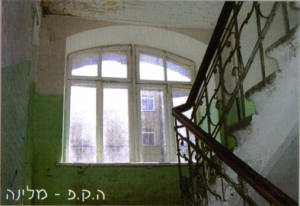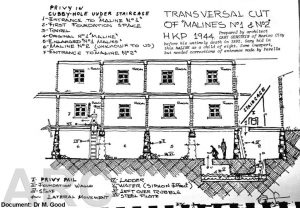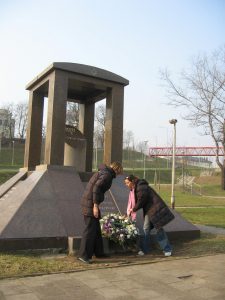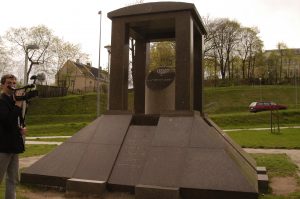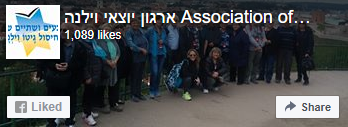H.K.P.
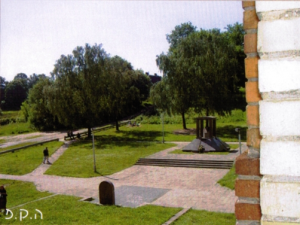 Written by Simcha Ben-Shaul
Written by Simcha Ben-Shaul
On the 24th of June, 1941 Vilna was occupied by the German army. Harsh restrictions were immediately imposed on the 70,000 Jews of Vilna. That summer marked the end of the illustrious community known as "Jerusalem of Lithuania". Engineering units of the German army came to Vilna and began setting up workshops to repair and maintain the Wermacht's armored vehicles and automobiles in various parts of the city. One of them was set up in former barracks of the Russian army. The huts and garages there were turned into workshops; another one was set up at a former bus station. At both of the workshops the engines of the vehicles were converted from liquid fuel to solid fuels such as wood for burning. Those workshops were part of the H.K.P. (Heereskraftfahrpark) of the Wermacht. The commanding officer of the unit was Major Karl Plagge; its headquarters were in the building of the Polytechnikum.
Most of the Jews from the ghetto who were employed in this unit (which was set up on the 6th of September, 1941) were car mechanics, panel beaters, carpenters, glaziers and the like. There were between 250 and 300 skilled laborers who were issued special work permits which guaranteed that they and their families would not be abducted during the various Aktions. The H.K.P. workers were considered lucky, partly because they were well treated by the commander of the unit.
The Vilna ghetto was liquidated on the 23rd of September, 1943. Some of the people there were transferred to labor camps in Estonia and Latvia and some were exterminated in the Valley of Death of Vilna Jewry in Ponary. Thousands were deported to Sobibor concentration camp in Poland where they were exterminated; a small number hid or joined the partisans in the forests. Before the extermination, from the end of August until the middle of September, the Germans set up a number of camps in the city and the workers and their families were moved there – only 4 members per family were allowed. One of the camps was H.K.P. 562 where the families were housed in two six-storey blocks. These buildings, built by Baron Hirsch at the end of the 19th century, were intended for the poor of the community, hence, they were known as "the cheap houses". At one stage, young pioneers who were preparing to make Aliyah lived there.
Within the confines of the H.K.P. camp, workshops were set up to repair, convert and dismantle vehicles, in addition to the abovementioned workshops of the unit that were in the city. The camp was cordoned off with barbed wire and was accessible through a side gate. The camp was guarded by soldiers of the Wermacht together with Lithuanian guards.
It transpired from documents and correspondence that were discovered after the war that this camp for Jewish workers and their families was initiated by the commander of the unit, Major Karl Plagge. He first went to Kovno and then to Berlin in order to convince his superior officers to let his Jewish workers live, as the time for the liquidation of the ghetto approached; he was also able to get permission for the families to join the workers (reasoning that that would raise the motivation of the workers and increase their productivity). It is fairly safe to assume that he feared that once the ghetto was liquidated he would be left without skilled laborers which would seriously compromise the unit's activities.
In August, 1943 Plagge prepared the first list of workers intended for the H.K.P. camp. However, after the Aktions began, many of his mechanics were deported to Estonia. At the beginning of September, Plagge gave an order to post the lists of names on the walls of the ghetto so that the workers could add the names of their families to their work permits, in his attempt to combat the problem,
On the 16th of September, 1943, approximately 250 of the H.K.P. workers and their families left the ghetto and moved with their families to the H.K.P. camp. One week later, on the 23rd of September, 1943, the SS began the liquidation of the ghetto. The Jews in the camp were legally under the authority of the SS, under the command of Richter, an SS officer who was nicknamed "bareneck" because of his very long neck. However, for all practical purposes, the daily life in the camp was the responsibility of Major Plagge and his unit.
Plagge was a mystery to the Jews. Death and terrible suffering on all sides in the Vilna ghetto increased, yet Plagge's workers were protected. Many of the workers gave Plagge credit for this. It was never really understood how and why he managed to protect his workers. In comparison to other concentration camps in Poland, the living conditions and work hours in H.K.P. were relatively decent. Of course, the food rations from the SS were tiny, however, a black market for the purchase of food developed in the camp and there was even a legally-operated general store. In the joint living quarters there was running water and a baking oven. People slept on beds and they could cook in their rooms. They were allowed to wear their own clothes instead of prison garb. The men would go to work in the workshops and the women mended the Germans' uniforms or darned their hose. There was a Jewish Council headed by Nonya Kolisch and also a small police force led by Paap the engineer, to maintain order.
After a few weeks of calm, the residents of the camp had a cruel reminder of how much their fate depended on the SS: one day in November all the camp workers were ordered to assemble in the courtyard by a gallows that had been set up by the Jewish police by order of the SS. Bruno Kittel, an SS officer, the murderer and liquidator of the Vilna Ghetto, drove into the camp in an open car. He was accompanied by SS soldiers who dragged in a Jewish woman, who had escaped from the camp, but whom Kittel had noticed on the street in Vilna. Kittel ordered to bring her husband (in fact, he was the man who appeared fictitiously as her husband on the camp lists) and her young daughter. Kittel made them both stand on their knees and he shot them in the head. He gave the order to hang "the husband" on the gallows. After the rope snapped twice (!), Kittle approached the man and shot him in the head. The following day, after the men had gone to work, the Gestapo ordered the camp police to drag all the women and children into the courtyard. Kittel stood opposite them accompanied by Lithuanian policemen and, when he gave the sign, they began to toss the women and children into trucks. When the Germans had filled the truck, about 35 people were taken to Ponary and exterminated there.
On Saturday, the 1st of July, 1944 Major Plagge appeared before the inmates of the camp and informed them that since the Red Army was approaching Vilna, they would be moved further west and the SS would be taking over. He said, amongst other things:"…and you well know how the SS takes care of Jewish inmates", thereby giving a clear hint of what was about to happen. Plagge informed them that the evacuation would begin on the 3rd of July. The SS increased the guard over the camp to prevent people from escaping. Anyone who had prepared a hiding place ("Malina") made preparations to hide there. A number of welders who worked in the workshop near the gate managed to cut the bars on the windows and escape. The inmates moved around the camp, desperate and panic-stricken, trying to find hiding places.
On the 3rd of July special units of the SS entered the camp and ordered the inmates to assemble. Only 600 Jews did so and they were taken by truck to Ponary and exterminated there. Once the Germans realized that only a small number of the inmates had assembled, they began a systematic search and found another two or three hundred. They exterminated those Jews in the camp itself. Approximately 350 people managed to hide or escape to the city or to the forests. 150 – 200 of them were handed over to the Germans by local residents. The remainder, including 25-30 children, survived the horror.
On the 13th of July, 1944 the Soviet Army liberated Vilna thereby ending 3 years of suffering, humiliation, plunder and murder.
In 2010, an international convention of survivors of the H.K.P. labor camp was organized in Beit Vilna, to convene a multi-generational meeting for this unique group.

